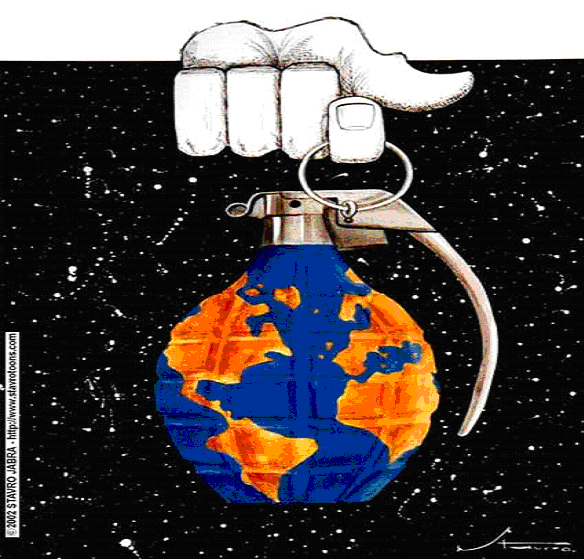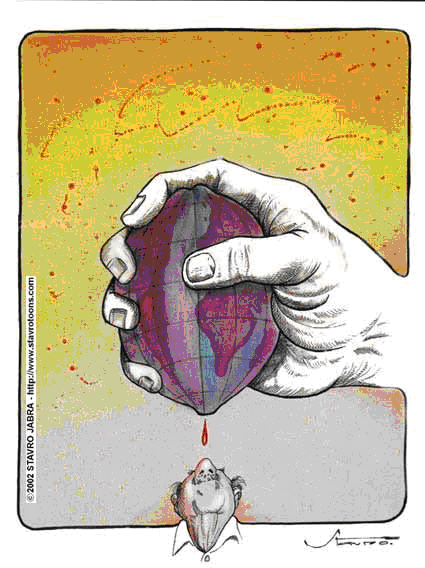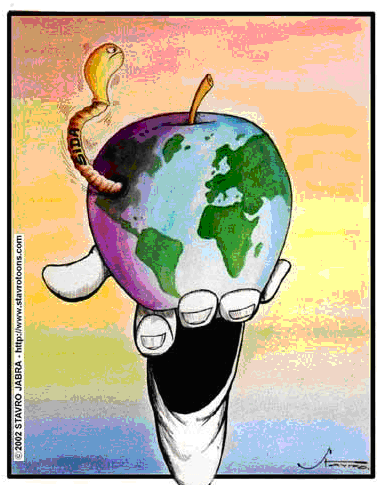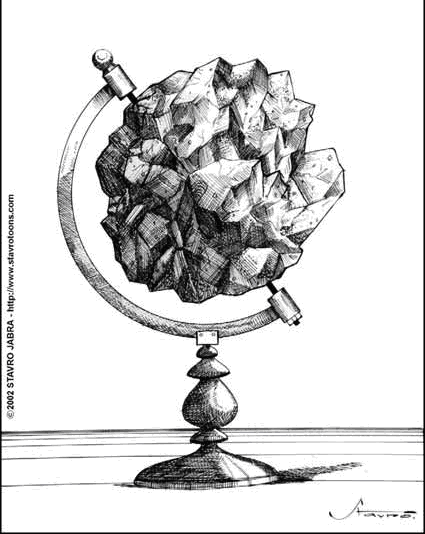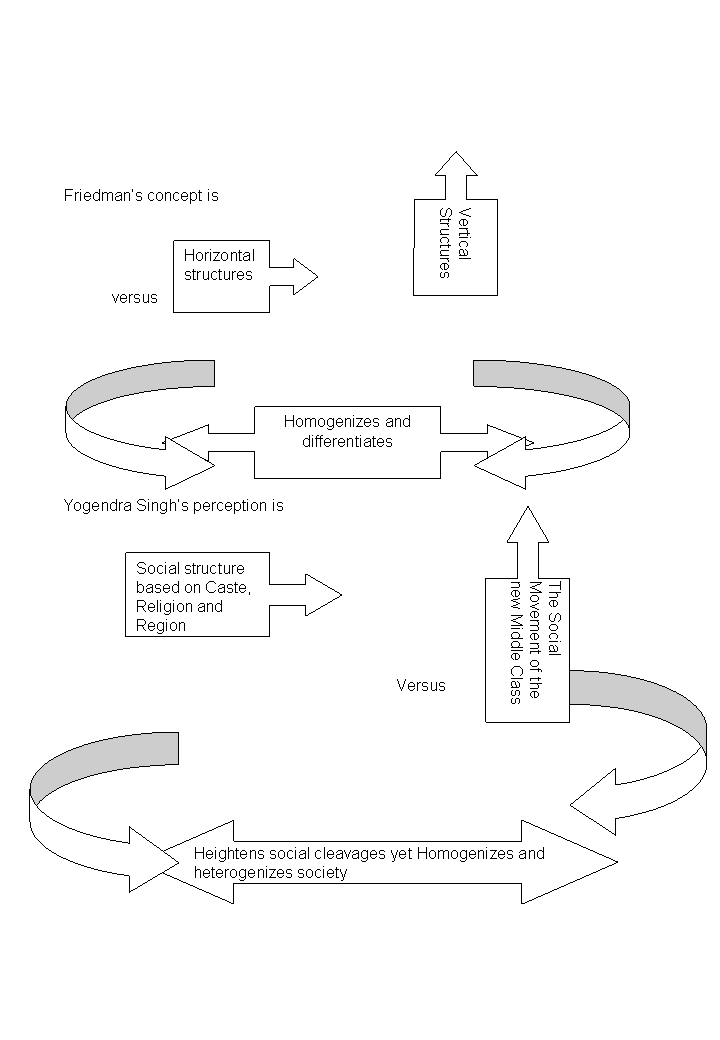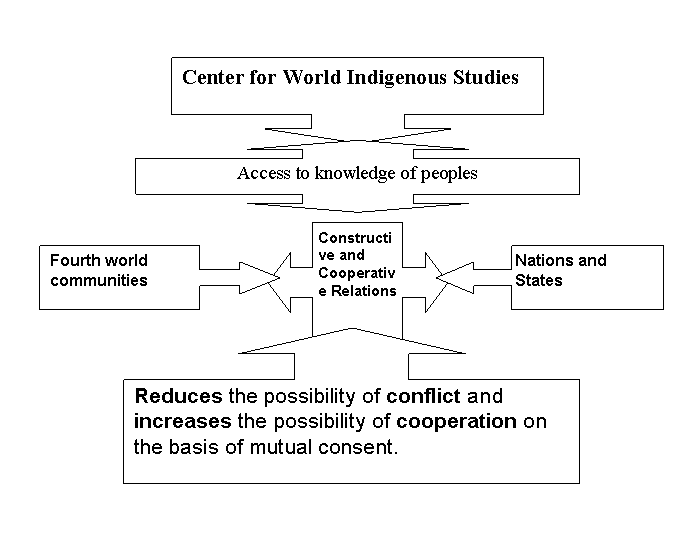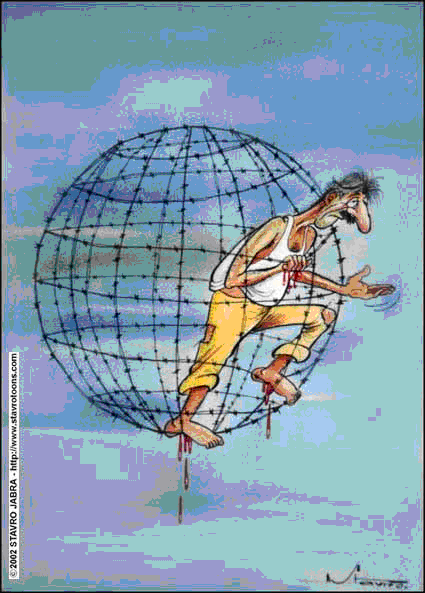ABSTRACT
'Globalization' is tentatively defined as the "interconnectedness" of nations at a purely surface level, namely economics. Viewed from the vantage point of the power of socio-cultural parameters, such as race, religion, language and the economy, 'globalization' is perceived as a narrative of contradictions and incoherence.
If Arthur Miller, the famous American writer, called "the Arts" a highway into the soul of the people with the power to unlock the secrets of global cultures, and when Sandeep Pandey returned his Ramon Magsaysay Award prize money because he is against 'American Hegemony,' is globalization really a 'leveler' or a 'divider'? Is it 'exclusive' rather than 'inclusive'?
Culture, the soul of people, is territorially conditioned. Although 'globalization' is meant to be culturally neutral, the language and content in gaining access to it is made out to be culturally homogenizing. This paper plans to show that contrary to the technologically and economically superior developed worldview of globalization, powerful non-English cultural territories are in the process of a counter effect.
1. INTRODUCTION
The most general view of 'globalization' is of the dominant power. The modern world-system, "has been able to flourish precisely because [it] has had within its bounds not one but a multiplicity of political systems" (Wallerstein, 1974), which holds the keys to the lives of humanity. There are differing manifestations, such as a monoculture, global neighborhood, global governance; etc. The following cartoon is taken to represent the dominant power of globalization.
This paper tries to present some interpretations of the concept with indications that global integration is superficial. Global debate has enhanced the consciousness of societies to delimit its spread so as to maintain cultural boundaries.
A JOKE
! Globalization !
Question: What is the height of globalization?
Answer: Princess Diana's death.Question: How come?Answer: An English princess with an Egyptian boyfriend crashes in a French tunnel, driving a German car with a Dutch engine, driven by a Belgian who was high on Scottish whiskey, followed closely by Italian Paparazzi, on Japanese motorcycles, treated by an American doctor, using Brazilian medicines! And this is sent to you by an Indian, using Bill Gates' technology, which he stole from the Japanese. And you are probably reading this on one of the IBM clones that use Philippine-made chips, and Korean made monitors, assembled by Bangladeshi workers in a Singapore plant, transported by lorries driven by Malaysians, hijacked by Indonesians and finally sold to you by a Chinese!That's Globalization!
Source:Yahoo.com
2. GLOBALIZATION: THE INTERCONNECTEDNESS OF NATIONS AT A PURELY SURFACE LEVEL
Through technological advances 'globalisation' has come to mean the economic and cultural interconnectedness of people in a world bereft of borders. It is a complex metaphor the world is experiencing, possibly, with the motive to expand links across humanity, to evolve a global consciousness. It is synonymous with 'modernization.' But with shades of difference. If we consider the works of postcolonial writers such as Chinua Achebe or Amitav Ghosh, they view 'globalization' as an emerging global phenomenon with seeds of 'progress' and 'destruction'. For Sree Krishna Alanahalli it meant the urban market products unsettling the rural fabric of our society.
Globalization according to Waters (1995) is
A social process in which the constraints of geography on social and cultural arrangements recede and in which people become increasingly aware that they are receding".Friedman (1999) views 'globalization' as
The inexorable integration of markets, nation states, and technologies to a degree never witnessed before, in a way that is enabling individuals, corporations and nation-states to reach around the world farther, faster, deeper and cheaper than ever before ... the spread of free-market capitalism to virtually every country in the world.Therefore, 'globalization' can be perceived as a historical transformation to vigorously spread and propagate practices, values and technologies in shaping human activities. It is emerging as a political response to the expansion of market power - a domain of knowledge (Mittelman, 2000) where power is intended to be centralized and un-sharable, borne out by the fact that most world organizations are moral covers for powerful nations who rule the world through a smokescreen.
The cartoon given below very deftly represents this dominant power.
The dominant powerful nations have discreet modes operating through 'peace-keeping missions' and 'rescue missions' to spread the kernel or the core of a global culture.
3. GLOBALIZATION - ITS DIFFERING MANIFESTATIONS
To some, 'globalization' is seen in concepts such as:
- Coco-colonization - a market created to promote a consumerist culture.
- Cultural imperialism overpowering local traditions; western ideals falsely established as universal.
- McDonaldization - a fast food doctored to spread efficient, controllable, and predictable human practices.
- Americanization - the hegemonic influence of the values and habits of the United States promoted through the news media and popular culture.
However, regardless of being a major phenomenon, which is crystallized through the Television media, political conflicts and rational progress through intellectual debates aggregates to what may be termed as constitutive streams of perhaps a common world culture.
4. GLOBALIZATION - CULTURAL ZONES
Race, religion, and language are the most potent symbols that keep nations across the world diverse as cultural zones. One view of literature on the concept of 'globalization' indicates that its effect is to encourage diversity, through 'Pluralization'; 'differentiation;' 'contestation;' 'glocalization;' and 'nation-states-institutionalization.'
- Pluralization is the interaction across boundaries, which leads to the mixing of cultures in particular places and practices.
- Differentiation is the cultural flow that occurs differently in different spheres and may originate in many places.
- Contestation is integration and the spread of ideas and images provoking reactions and resistance.
- Glocalization is global norms or practices, which are interpreted differently according to local tradition; the universal must take particular form.
- Institutionalization is diversity that has itself become a global value, promoted through international organizations and movements, not to mention nation-states. (The Globalization website)
The next cartoon shows the compartmentalization of the globe.
"Progressive" forces counter globalization crystallizing it as opposition of a "conservative" kind. For some religious activists it represents a civilizational threat. They perceive homogenization of the globe on secular terms as imposition of alien values. Some non-religious activists both 'right' and 'left,' see it as the hegemonic power of the United States that 'influences globalization to its own advantage, harming the economic, cultural, and environmental interests of the rest of the world' (Ibid).
The Oxfam (UK) policy paper argues that it has widened the gap between the rich and poor; and to bridge it, new global institutions will be needed. The WTO, for example, serves corporate interests but is a threat to democratic values and is hastening deterioration of the environment.
5. GLOBALIZATION - IMPACT OF DIFFERING MANIFESTATIONS
If 'globalization' is towards consolidation of a world society, it could mean 'social change,' or 'modernity.' Critics see it as 'an economic nightmare for the poor' or that 'it is not only a process but also a paradigm, a novel way of thinking about the world that has contradictory implications.' This is largely beneficial but also presents new risks, with an irreversible process affecting everyone (ibid). On the one hand, critics of capitalism protest at the international economic institutions to denounce global markets claiming that it is a 'race to the bottom,' whereas Tomas Larsson, (2002), a Swedish journalist, sees it a 'race to the top.' Reporting from the slums of Rio and a bicycle factory in Korea, his view is that the spread of global markets enables poor people to leave behind poverty and misery and merge with the global middle class.
Yogendra Singh (1993) views social change in India as merely change in its social structure, heightening social cleavages brought about by the new middle class and challenging traditional values in the race towards upward mobility. While clinging on to grass root cultural ideologies of caste, religion, and community, the social movement sweeping the country through the new middle class professionals, youth and women, that cuts across caste, region and religion, creates a culture where homogenization and heterogenization may actually operate in tandem or even reinforce each other, heightening incoherent societal contradictions.
"Horizontal Society" is Friedman's metaphor of the late 20th century modernity (1999). It is a contrast to the "vertical structure of society". Persons similarly situated and identified through categories such as gender, ethnicity or nationality is "Horizontal Society," whereas "vertical structure of society" is built around family, extended kinship and authority relationships (master-servant; land-owner-tenant; priest-parishioner). 'Modernity has two faces - it homogenizes and differentiates. It pulls people apart and pushes them together. It accentuates ethnic differences, but in the context of a single (Powerful) world culture.'
What I am trying to present are the contradictions that seem to be occurring on the scene of globalization. We perceive globalisation as leading to a global culture but let us look at a possible interpretation of Friedman (1999).
For a clear picture of Friedman's concept, please go to the printer friendly version, because the visual is too large to be reproduced with clarity in this page.
Friedman as well as Singh interprets the process of globalization as the simultaneous and parallel nurturing of cultures.
6. IMPACT ON LANGUAGES - THE STARK REALITY
The sacred principle of the EU is to maintain a delicate and expensive equilibrium between linguistic imperialism and communications chaos. However, the European Union, or the United Nations, are caught between two necessities, and that is, to understand each other in their discussions, and at the same time make certain that no one linguistic group is at a disadvantage. But the stark reality is the receding status of the small non-powerful languages. Many languages are on the brink of extinction. Of the world's 6800 tongues, half to 90% is predicted to become extinct by the end of this century, because, as the UNESCO says, languages need at least 100,000 speakers to survive the ages.
Illusory benefits, as portrayed by powerful controls, can create a setback for languages of small nations joining global institutions. For example, in the beginning of the 19th century, the Czech scholar Josef Dobrovsky sat down to write the dictionary in his dying language. Linguists called it a miracle, because it challenged the politically powerful German language to reach Czechs' national language for 200 years and now if Czechs are to join the European Union, what will happen to the language? A recent poll in Latvia showed that 52% of Latvians worry that joining the EU will threaten their language again. By contrast, only 48 % were concerned about the loss of their national currency. (Farnam, 2002)
In spite of the fact that the world is becoming less diverse, communities across Botswana, Cornwall, England (Cornish), and the South America (ancient Mayan languages) are trying to revive their languages. From the methods used by the developing nations in planning the survival of their languages, it looks as if these languages may yet withstand the onslaught of globalization.
Looking at the Indian languages, the scenario is one of planning and raising the status of the regional languages. Besides strategic planning and implementation of the language policies by the governments at the centre as well as the states, non-government organizations like KATHA are working to arrest the decline of oral literatures. They are finding ways to capacity build storytelling and vibrant writing on the Internet. They keep the languages alive through translation, publishing and networking through the CBSE schools to include Bhasha literatures in the syllabi at formal levels.
7. GLOBALIZATION - CULTURE TERRITORIALLY CONDITIONED
Indigenous communities
At the grass root of cultural identities, are the rising voices of the small indigenous communities. Through The Center for World Indigenous Studies (cwis.org) the consciousness of the right to conserve the local identity is simultaneously happening. They are the 'Fourth World' (ibid) in their understanding of humanity. Their main objective is
Towards Constructive and Cooperative Relations between Fourth World communities and Nations and States working towards the underlying principle of 'Access to knowledge and peoples,' with ideas that reduces the possibility of conflict and increases the possibility of cooperation on the basis of mutual consent. By democratizing relations between peoples, between nations and states, the diversity of nations and their cultures will continue to enrich the world (ibid).They work towards the possibility of bridging the gap between the jungle and the city through basic ideas like Women's traditional healing, integrative medicines and the like.
The following diagram graphically depicts the totality of their endeavor.For a clear visual of the scheme presented by the Center for Indigenous Studies, please go to the printer friendly version, because the visual is too large to be reproduced with clarity in this page.
It is seen as global interdependence across humanity with local cultural distinctions. The following cartoon is taken to show the 'exclusiveness' of cultures, to select the best of both the worlds.
The thrust of their endeavor is to save and preserve local cultures. And at the same time catch on to the bandwagon of global following. The rippling voices on the Television are too tempting to avoid miming a bit of the 'other's' melody and would like to avoid a situation, which is portrayed very well in a cartoon by stavrotoon.com
Klaus Toepfer (2002) said conserving and promoting cultural diversity was no nod in the direction of nostalgia. He said it was an "economic imperative." The United Nations Environment Programme finds a 'firm link between cultural and linguistic diversity and biodiversity,' where languages, when endangered, stand to lose out to the riches of biodiversity, which is the wealth of animal and plant life.
One of the concerns, therefore, seems to be language as the most potent symbol of national identity. Even if currencies across the continent are being united and religion is taking a back seat, all EU candidate states insist that their national languages gain equal status. But the economics of the use of many languages is not viable. EU institutions currently use eleven official languages that according to Farnam (ibid) create combinations of 110 languages in translation and interpretation by employing thousands of interpreters and translators at a cost of 686 million euros per year. Planned expansions of the Union in the next decade will add another 10 official languages, raising the number of combinations to 420 which will require hiring interpreters between languages such as Latvian and Portuguese or Hungarian and Dutch. If that is too expensive and impossible, then according to Katinka Barysch, chief economist at the Center for European Reform, London, "the problem is that there would be intense nationalist resistance to any change. Especially in the new states in Central and Eastern Europe, language is a symbol of freedom from domination." Accommodating more languages will be prohibitively expensive and impractical.
8. EMPLOYMENT OF MINORITY GROUPS
The world continues to see small groups fight for and achieve empowerment. East Timor formally became a separate nation on May 20, 2002, following a vote for independence from Indonesia. Many indigenous peoples around the world seek this freedom to decide their political future.
The land-locked state of Bhutan has woken up from its inclusive reverie.
In September 1991, a phonological romanization for Dzongkha, the national language of Bhutan, was introduced as an official standard by the Chairman of the Dzongkha Development Commission. Roman Dzongkha, as it was called, was not intended to replace traditional Bhutanese writing, but to accurately and adequately represent the phonology of the living language and to serve as a standard for representing Dzongkha names and words in the international media. However, the actual use of the system in Bhutan at present cannot be verified. Existing sources, including Bhutanese media (the Kuensel newspaper), seem to continue using traditional name forms (UN Working paper 15, 2000).Over the last two years Bhutan has been working towards computerizing their national language so as to have access to information and knowledge through their native language.
Inter-Korean relations, cold since the 1950-53 conflict, showed the hope of bridging the peninsular divide when the North's flag fluttered in the South's city of Busan from September 29 to October 14 2002 in the Asian Games.
In Karnataka, the scene to 'glocalize' is apparent from the many advances in connecting the village to the globe. The 'Bhoomi Project' of Karnataka government-to-citizen initiative, targeting farmers, has computerized 20 million land records as on 26.9.02, making land records easily available to farmers at an affordable price. One of the intentions being that it is the nucleus that connects the Indian villager with the world around him. The land records contain details of crops grown in specific areas, information which is of importance to companies to update their database. Development of the 'simputer,' low cost hand held computer, which uses indigenous language and software, is being geared targeting the rural base.
Mukhya Vahini, a government-to-government Management Information System is designed to be the digital cockpit for every decision maker in Karnataka with a view to decentralize the nature of governance in the State. E-transformation of the administration in Karnataka to e-governance in a phased manner to integrate departments, to simplify and rationalize procedures, and thereby restructure the system is in the same direction.
9. VIEWS ON ENGLISH AS A GLOBAL LANGUAGE
According to Ammon (1992:78),
- English has the greatest number of speakers reaching as many as 1.5 billion people.
- English is designated as official languages of as many as 62 nations.
- English is the most dominant language in scientific communication with 70-80 percent of academic publications being published in it.
- English is the de facto official and working language in most international organizations.
- English is the most taught foreign language across the world.
But, for the non-English language speakers, the English language is insensitive to the cultural nuances of other languages. It, kind of, acts as a leveler in relational situations. The honorific mode of address and reference in terms of address prevalent in the Indian languages is simply leveled off. For example in Hindi /aap/ /ve/ - the plural honorific pronouns and verbal constructions, and at the non-honorific levels /tum/ both in 'pronoun' and in 'verb' form is in the singular egalitarian mode of 'you'. Similarly, /hum/ (we) and /mai/ (I). In English 'we' and 'I' differentiate /one/ from the /other/. In Hindi, 'we' for the first person singular cuts across both ways, the egoistic 'I' merge with the all round 'us.'
Yukio Tsuda, (ibid), looks at it as 'neocolonialism' and 'globalism.'
English for the non-English speaking world is perceived to be a crucial threat to the development of human and cultural security and proposes a paradigm to counter attach the hegemony of English by proposing the Ecology of Language Paradigm as a counter strategy.
'The arts', Arthur Miller, the famous American writer said, is 'a highway into the soul of the people, that do more to sustain peace than any wars. When the cannons have stopped firing, and the great victories of finance are reduced to surmise and are long forgotten, it is the art of the people that will confront future generations.'
There is an interesting debate within Kannada literature that treats globalization in its multifarious manifestations. If we take up a writer like U. R. Ananthamurthy, he views it in terms of modern education and propounds for the uplift of our downtrodden societies. Bharathipura can be a good example in this regard. For Tejaswi, it comes to be associated with communication institutes and technologies as portrayed in his book Abachurina Post Office.
10. CONCLUSION
The process of 'globalization', if seen as a bid to seep into the house of wisdom of peoples' culture, has stopped short at the threshold of their inner consciousness. Like infinite oceans on which lines cannot be drawn, the creative potentiality of a people, their language, thought and reality cannot be dissociated. Language, the principal avenue to the totality of a culture, can often create intolerance to cultural differences when barriers emerge in the context of cross-cultural communication. And, thus, the contradictions lie wide open in a world trying to deconstruct the tower of Babel or rather trying to complete the full circle.
Globalization, like many metaphors, is to be seen as a currency system, like the gold standard, or like 'beauty,' which is not universal or changeless. It is an expression of power relations in which nations compete for resources that are not their own. Marketing resources of the powerless communities is limited and will thus vanish in the ocean of lost cultures. Multi-lateral cultural exchanges seem to be emerging with the major social groups highlighting their sense of originality and identity.
REFERENCES
1. Ammon, U. 1992. The Hegemony of English and Strategies for Linguistic Pluralism: Proposing the Ecology of Language Paradigm. Yukio Tsuda. Graduate School of International Development. Nagoya University. Aichi 464-01, Japan.
2. Farnam, Arie. European Union's expansion sparks questions about language. Christian Science Monitor. Newsobserver.com.
3. Friedman, Lawrence M. 1999. The Horizontal Society. New Haven. Yale University Press. Reviewed by Herbert M. Kritzer. Department of Political Science. University of Wisconsin-Madison in Law & Politics Book Review. Herbert Jacob. Editor. Vol. 9.No. 11. pp 482 -485.
4. Friedman, T.L. 1999. The Lexus and the Olive Tree. P.7-8.
5. Klaus Toepfer. 2002. Big Development Project Need Cultural Impact Assessment. 4th International 4th International Conference of the International Alliance of Indigenous and Tribal Peoples of the Tropical Forests taking place in Nairobi, Kenya, Mittelman, J. H. 2000. The Globalization Syndrome. p. 6.
6. The Globalization website.
7. Tomas Larsson. 2002. The Race to the Top: The Real Story of Globalization. The Cato Store.
8. Waters, M. 1995. 'Globalization' (p. 3).
9. Yogendra Singh. 1993. Social Change in India: Crisis and Resilience. New Delhi. Har.-Anand Publ. pp 12-40.
10. United Nations Group of Experts on Geographical Names Twentieth Session, Working Paper No. 15. New York, 17-28 January 2000 . Item No. 7 of the Provisional Agenda: Summary Reports of the Working Groups . Report by the convenor of the working group on Romanization systems. Submitted by Peeter Päll. Institute of Estonian Language. Roosikrantsi 6. EE-10119. Tallinn,Estonia. peeter@eki.ee
11. Wallerstein, I. 1974a. The Rise and Future Demise of the World Capitalist System: Concepts for Comparative Analysis. Comparative Studies in Society and History 16:387-415
12. The Times of India, 5.9.02.
